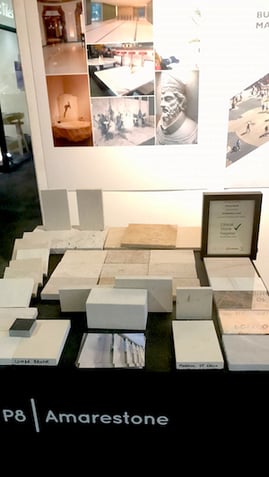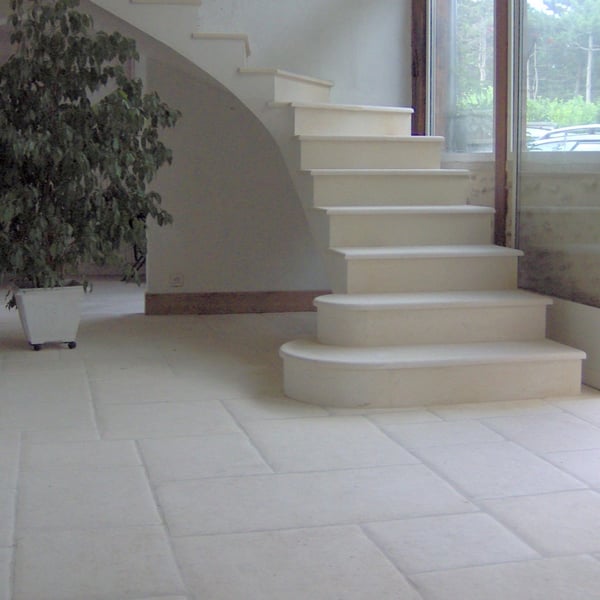Natural Stone at the Surface Design Show:
The top 5 questions asked by Architects and Designers
This year's Surface Design Show at London's Business Design Centre in Islington attracted a large audience of architects and designers who came to look at the wide range of innovative surfaces on display at the show.
For the 6th year running, we exhibited a range of natural stone alongside fellow members of the Stone Federation Great Britain where we formed part of the Stone Zone Knowledge Hub.
 Although our display plinth was just a small space, we took a few samples from selected quarries in France, Portugal and the UK
Although our display plinth was just a small space, we took a few samples from selected quarries in France, Portugal and the UK
Part of the reason for being at the show was to provide an opportunity for visitors to chat with the Stone Federation members so that they can get answers to their questions about choosing and using natural stone in their projects.
It's always interesting to chat face to face to specifiers of natural stone to see what questions arise and I've picked out 5 of the most common questions that we were asked last week.
Question 1:
The most popular question this year, probably because we displayed our certificate on the table, was about our membership of the Ethical Stone Register.
What does the Ethical Stone Register mean and why does it matter?
Answer: A few years ago, a couple of large and reputable suppliers of natural stone made the press headlines when it was discovered that some of their products came from quarries in India that used child labour. As a response to this negative attention but also to make a positive statement about the sustainability of natural stone, the Ethical Stone Register was created. It was designed to provide stone specifiers with a single source point for ethically and responsibly sourced natural stone. There is more detail on our blog that describes our journey onto the Ethical Stone Register.
Question 2:
We had always seen lots of interior designers at the Surface Design Show but I wasn't expecting to speak to quite so many landscape designers. This led to the next most popular question.
Which limestones can be used outside?
Answer: The simple, but unhelpful, answer is that it depends. It depends on the answers to some additional questions. For example, is the limestone going to be used in a frost zone? If so, we need to consider the ability of the stone to withstand repetitive freeze/thaw cycles. You can see our blog that answers the frost resistant limestone question more fully. How is the stone going to be used? Is it for wall cladding or paving? Does it have to withstand heavy traffic or light footfall? There are many considerations when considering which stone can be used outside. We have a range of blogs that address the topic of external stone.
Question 3:
One of my favourite questions to be asked when we're exhibiting at a show is the one where most people love the answer.
What sizes do the tiles come in?
Answer: Customers who buy "off the shelf" products are used to the idea of being limited to whatever size is in stock. But we source stone specifically for the project so it's more a question of what size you would like or what best suits the project. There are constraints such as the maximum block size the quarries can handle and their factory processing capability but this does not normally restrict the choice of tile size. The constraint is more likely to come from the practicalities of the installation or the budget. So, the answer is that the customer can have pretty much any size.
Question 4:
This question crops up time and time again when we are meeting visitors at the trade shows.
Is it suitable for underfloor heating?
Answer: It shows the importance that people place on incorporating an appropriate heating system in new flooring projects. Natural stone works beautifully well with underfloor heating whether it's an electric under tile cable system or a wet, in-screed system. Many modern homes are built with only underfloor heating and no longer use radiators.
There are some things to consider, such as using anti-fracture (or de-coupling) matting to prevent cracks caused by thermal expansion. This is the case whether you use stone or ceramic or porcelain tiles. We can advise on how the substrate should be prepared to maximise efficiency and minimise running costs.
Question 5:
OK, so this particular question is quite rare but as we had two successive visitors to the stand who asked, I was prompted to include it here.
Can limestone be used for staircases?
Answer: Yes, definitely. It's worth considering the different construction methods of stone staircases so that the correct type of stone with the correct technical characteristics can be selected. Some of the French and Portuguese limestones are perfect for the elegant types of floating, cantilevered and post tensioned staircases. These require stone that meets specific technical criteria. The design, construction and installation of these staircases should be carried by specialists. For a simpler solution, stone can also be used to clad pre-formed concrete staircases. In each case, the stone can be given an appropriate surface finish to provide the required slip resistance.
Chauvigny French limestone staircase and paving
--------------------------------------------------------------------------------------------------------------------------
If you have any other questions or need expert help with your natural stone project, please call us on 0345 260 80 70 or email steve@amarestone.com.
Thanks for reading.
Steve Turner
Amarestone
Tel: 0345 260 8070
P.S. - get the next blog direct to your inbox by entering your email address in the box on this page.



